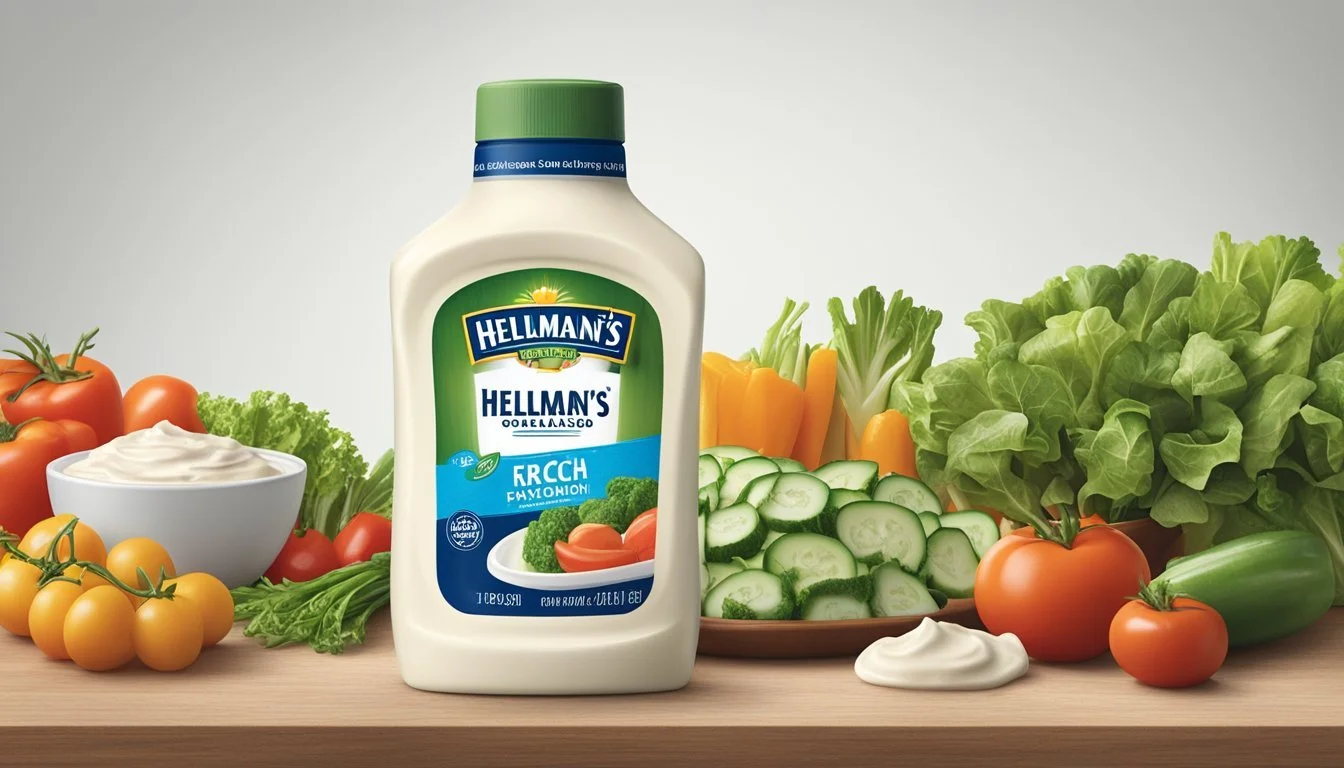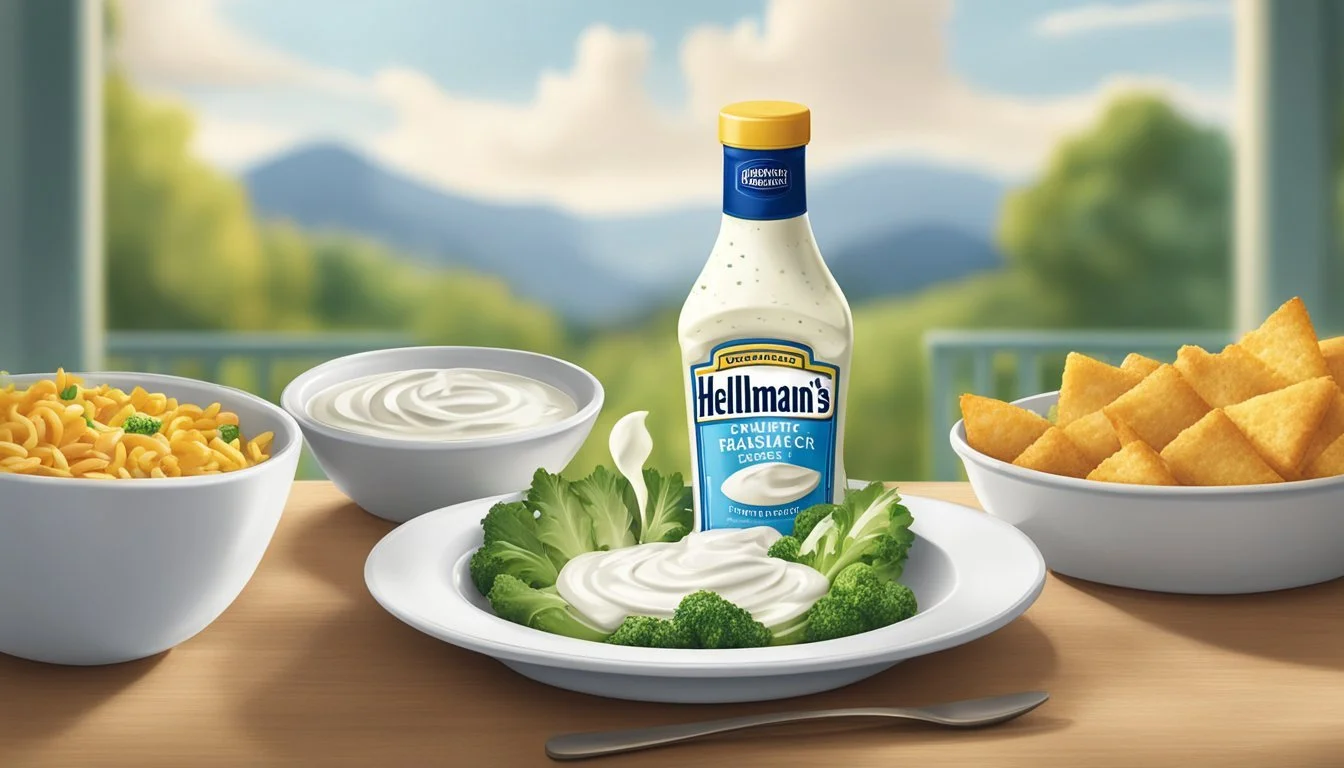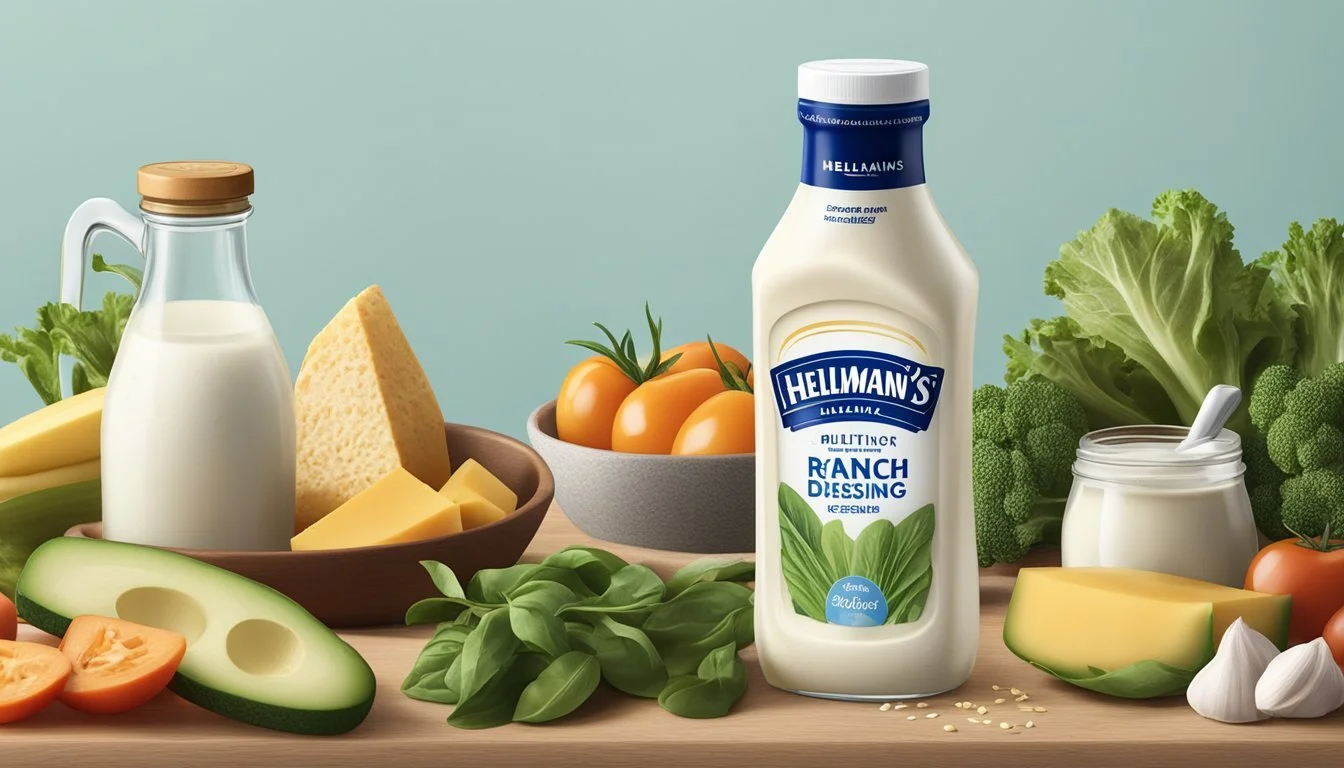How Much Hellmann's Ranch Dressing Per Day Exceeds Healthy Limits?
Determining the appropriate amount of Hellmann's ranch dressing to include in a daily diet regimen requires a nuanced understanding of nutrition and personal dietary needs. Hellmann's ranch dressing, like many creamy salad dressings, is rich in calories and fats. Specifically, options like Hellmann's Classic Ranch Dressing contain approximately 180 calories per 43-gram serving, predominantly from fats. While the inclusion of ranch dressing can enhance the flavor of meals, mindful consumption is essential, especially considering the calorie-dense nature of such dressings.
Individual dietary requirements vary greatly, influenced by factors such as age, gender, weight, activity level, and overall health goals. Ranch dressing, while flavorful, can contribute to exceeding daily caloric and fat intake recommendations if not portioned carefully. Health-focused individuals often seek lighter alternatives, such as Hellmann's Light Ranch Dressing, which contains lower calories per serving. Nonetheless, understanding the nutritional content of Hellmann's products is paramount in integrating these condiments into a balanced diet without overindulgence.
What Is Ranch Dressing?
Ranch dressing is a creamy type of salad dressing that is widely popular in the United States. It boasts a rich, smooth texture, which is primarily due to its mayonnaise base, often accompanied by buttermilk and sour cream. The dressing is well-loved for its tangy flavor that balances the richness of the primary ingredients.
The classic flavor of ranch dressing is achieved by incorporating a blend of herbs and spices, which often include parsley, dill, garlic, onion, chives, and black pepper. This herbaceous profile is sometimes enhanced with a hint of sugar for sweetness, creating a multi-dimensional taste that complements a variety of dishes.
There are numerous variations of ranch dressing available on the market, and Hellmann's Classic Ranch Dressing is one such commercial example. However, enthusiasts might opt for homemade ranch dressing, where they can control the ingredients and the level of fat content. Typically, commercial ranch dressings have a higher fat content due to their mayonnaise and sometimes buttermilk content.
When consumed in moderation, ranch dressing can be part of a balanced diet. However, due to its fat and calorie content, dietary guidelines suggest moderate consumption, especially when considering daily caloric and fat intake limits.
Nutritional Profile of Hellmann's Ranch Dressing
Hellmann's Ranch Dressing is a popular condiment that offers a creamy texture and a blend of herbs and spices. Understanding its nutritional profile is essential for those who are health-conscious or monitoring their daily intake.
Calories and Macronutrients
Hellmann's Creamy Ranch Dressing contains approximately 110 calories per 43g serving with a calorie distribution of 89% fat, 11% carbs, and 0% protein. The Classic Ranch variety has about 180 calories per 43g packet, with similar macronutrient ratios, primarily composed of fat. The Light Ranch version has notably lower calories, at 60 per 43g serving.
Vitamins and Minerals
Ranch dressings generally provide minimal vitamins and minerals. Specific micronutrient levels for Hellmann's Ranch Dressings are not typically highlighted, indicating that the product may not be a significant source of these nutrients.
Daily Values and RDI
The Ranch Dressing varieties contribute to the daily intake of fat and sodium. For saturated fat and sodium, it is important to consider the percentage of Daily Value (%DV) that a serving contributes in the context of a 2,000-calorie diet.
Comparison to Other Varieties
The nutritional values of Hellmann's differing Ranch dressing choices vary, mainly in terms of fat and calorie content:
Original Creamy Ranch: High in fat and calories.
Light Ranch: Reduced fat, lower calories.
Fat-free variants: Not mentioned in the search results, but typically contain negligible fat.
Difference in Serving Sizes
Serving sizes can influence calorie and nutrient intake significantly. A standard serving size for Hellmann's Ranch Dressings is typically around 43g or one packet.
Healthier Alternatives
For a healthier option, choosing the Light Ranch Dressing would be beneficial due to its lower calorie content compared to the Creamy Ranch variant.
Comparison to Other Salad Dressings
Ranch dressing is higher in calories and fat compared to lighter options like vinaigrettes or Italian salad dressing. It tends to be similar to Creamy Caesar dressing in terms of calories and fat content.
Impact on Weight Loss Effort
Consuming high-calorie dressings such as Hellmann's Creamy Ranch in large quantities can make it more challenging to maintain a calorie deficit which is often necessary for weight loss.
Homemade Alternatives and Recipes
Creating a homemade Ranch dressing using ingredients like buttermilk, dill, parsley, chives, garlic, and lemon juice can offer more control over the nutritional values and eliminate certain additives.
Common Additives and Allergens
Processed dressings typically contain additives for flavor and preservation. Common allergens in ranch dressing include dairy products and sometimes soy or egg derivatives.
Ranch as an Ingredient Beyond Salads
Besides salads, Ranch dressing is often used as a dip, a sandwich spread, or an ingredient in various recipes, impacting the overall nutritional intake when consumed in these forms.
Nutritional Values of Flavored Variants
Flavored variants like Chipotle Ranch or Garden Ranch may have different nutritional profiles due to added ingredients. These can alter the calorie, fat, and sodium content.
Ranch Dressing in Different Cuisines
While Ranch dressing is a staple in American cuisine, it is less prevalent in other culinary traditions. Its inclusion typically doesn't significantly alter the traditional nutrient profiles of those cuisines.
Dietary Considerations with Ranch Dressing
When considering Hellmann’s ranch dressing as part of a diet, it's essential to evaluate its nutritional profile, including sodium and fat content, the presence of carbohydrates, sugars, and proteins, as well as how it aligns with healthy eating guidelines and potential allergens.
Sodium and Fat Content
A single 43-gram packet of Hellmann’s Classic Ranch Dressing contains 180 calories with a high fat percentage. Specifically, there are 19 grams of fat, which consist of saturated, monounsaturated, and polyunsaturated fats, but the exact amounts of these subtypes are not detailed in the available nutritional information. In terms of sodium, ranch dressing is known to have a notable sodium content that contributes to its savory flavor, but exact figures for Hellmann's variant are not provided. Excessive intake of sodium and fat can have negative health implications, thus moderation is key.
Carbohydrates and Sugars
Carbohydrate content in Hellmann’s ranch dressing is relatively low, with a single packet containing around 2 grams of carbs. The type of carbohydrates present includes sugars, yet in very minimal amounts. For those monitoring their carbohydrate intake, ranch dressing can be considered a low-carb option; however, additive sugars should still be watched for overall health.
Protein and Dairy Content
Hellmann’s ranch dressings contain little to no protein. As a dairy-based condiment, it includes ingredients such as milk and natural flavors which may be derived from dairy sources. Individuals incorporating ranch dressing into their diet must consider their protein sources should not rely on this dressing as a significant supplier.
Healthy Eating Guidelines and Ranch Dressing
Ranch dressing can be a flavorful addition to a diet, but its nutritional values must be accounted for within the daily values suggested for a balanced diet. High in fats, especially if consumed in large amounts, it can contribute to the ingestion of excess calories. Individuals should ensure that the intake of such dressings aligns with their diet regimen and healthy dietary patterns, which emphasize the moderation of high-fat and high-calorie foods.
Allergy Information
Hellmann's ranch dressing typically contains dairy, which may include milk solids or cheese cultures. Those with dairy allergies or lactose intolerance should avoid ranch dressings or seek dairy-free alternatives. The label should be reviewed for potential allergens, including reactions to certain natural flavors or additives that some individuals may be sensitive to.
Culinary Uses and Recipes
Hellmann's ranch dressing is versatile in its applications, ranging from a classic salad dressing to an inventive sandwich spread or dip. The section below explores various recipes and culinary uses that can enhance the flavor profiles of everyday meals.
Classic Ranch Dressing Variations
The traditional ranch dressing can be tailored to suit individual tastes by adjusting ingredients like buttermilk, mayonnaise, and sour cream. Herbs such as dill, parsley, and garlic, along with lemon juice, enrich the classical ranch with a fresh taste. To create a Chipotle Ranch Dressing, one could blend in chipotle peppers for a smoky, spicy twist.
Innovative Ranch Recipes
For a diverse culinary approach, ranch can be transformed into Creamy Jalapeño Ranch Dressing by adding chopped jalapeños and avocado, or into a Smoked Peach Dressing by incorporating smoked peaches for a sweet and savory balance. Moreover, a Creamy Chili Honey Sauce can be achieved by integrating chili and honey into the base ranch dressing.
Ranch Used in Popular Foods
Ranch dressing is a popular condiment for more than just salads. It serves as a seamless addition to casseroles and is a go-to dip for vegetable platters and snacks. Additionally, it’s often used as a sandwich spread to add moisture and flavor to various sandwiches and wraps.
DIY Ranch Dressing Preparation
Creating homemade ranch dressing is a simple process involving common ingredients such as fresh herbs, yogurt or buttermilk, and olive oil. A combination of black pepper, Dijon mustard, garlic powder, and dried dill can provide a robust flavor. Lemon juice may be added for a hint of zest, completing the homemade ranch experience.
Health and Nutrition: Understanding the Labels
In this section, the focus will be on breaking down the nutrition facts and understanding both the daily values and serving sizes on Hellmann's ranch dressing labels, which are essential for managing consumption.
Analyzing Nutrition Facts on Ranch Dressing Labels
When examining the nutrition facts of Hellmann's ranch dressing labels, one can observe that a single serving of the Classic Ranch Dressing contains 180 calories and 19 grams of fat, while the Creamy Ranch Dressing provides 110 calories and 11 grams of fat. Both varieties contain a minimal amount of protein at 0 grams, and the carbohydrate content is 2 grams and 3 grams, respectively. The Light variant stands out with only 60 calories, but an analysis indicates that it has a significantly reduced fat content, potentially replaced by other ingredients to maintain flavor.
Nutrient Classic Ranch (per packet) Creamy Ranch (per packet) Light Ranch (per packet) Calories 180 110 60 Fat (grams) 19 11 Data Not Available Carbohydrates (grams) 2 3 Data Not Available Protein (grams) 0 0 0
Interpreting Daily Values and Serving Sizes
Understanding daily values and serving sizes is critical when considering the impact of Hellmann's ranch dressing on one's diet. The Daily Value (DV) gives a benchmark for nutrient intake and is based on a 2,000-calorie diet for adults. Knowing that the DV for total fat is less than 78 grams, one can calculate that a single serving of Hellmann's Classic Ranch Dressing provides about 24% of the DV for fat. Comparatively, the Creamy Ranch offers approximately 14% of the DV for fat.
Serving sizes must also be carefully regarded, as they impact calorie and nutrient intake. Each packet mentioned above is standardized at 43 grams, with the DV for sodium recommended to be less than 2,300 milligrams. Even though the exact sodium content is not stated, it is vital to account for it, especially for individuals monitoring their sodium intake. It's worth noting that these figures are not fixed and can vary depending on an individual's dietary requirements, activity level, and health goals.
Legal and Copyright Aspects
In discussions about Hellmann's ranch dressing's daily consumption, it is paramount to consider the legal frameworks surrounding the brand's intellectual property and the regulations governing nutrition and health claims. These aspects ensure the preservation of proprietary recipes and adherence to standards that safeguard consumer health.
Intellectual Property of Brand Recipes
Hellmann's ranch dressing is a product of Unilever, a company that holds the intellectual property rights to the recipe. Copyright protection applies to the labeling, branding, and unique aspects of the product's presentation but does not extend to the list of ingredients themselves. Recipes, as functional products, are typically not copyrighted; however, unique processes and trademarks can be protected under intellectual property law to prevent misuse or misappropriation of the Hellmann's brand identity.
Nutrition and Health Claims Regulation
The nutritional content of Hellmann's ranch dressing follows the guidelines set by food safety authorities, which regulate the claims manufacturers can make about their product's health benefits. The Nutrition and Health Claims Regulation stipulates that any claims must be evidence-based and clearly communicated to consumers:
Nutritional Values: Labels must accurately reflect the dressing's content, such as fat, carbohydrates, and proteins.
RDI: Recommended daily intake (RDI) information may guide consumers on how much ranch dressing consumption is appropriate within a daily diet.
Labels cannot suggest that overconsumption aligns with a healthy lifestyle. It is pertinent to note that this dressing contains a high percentage of fat, indicating that moderation is essential for dietary balance.








